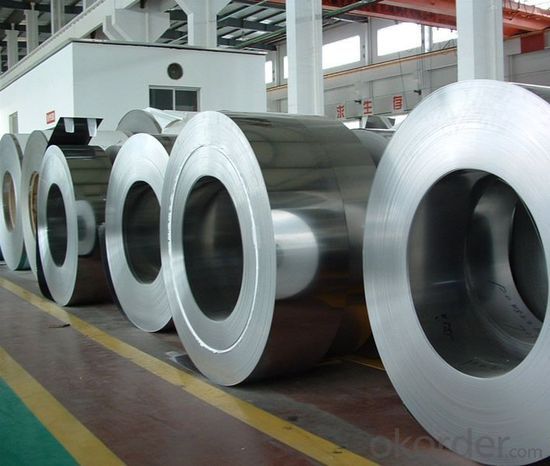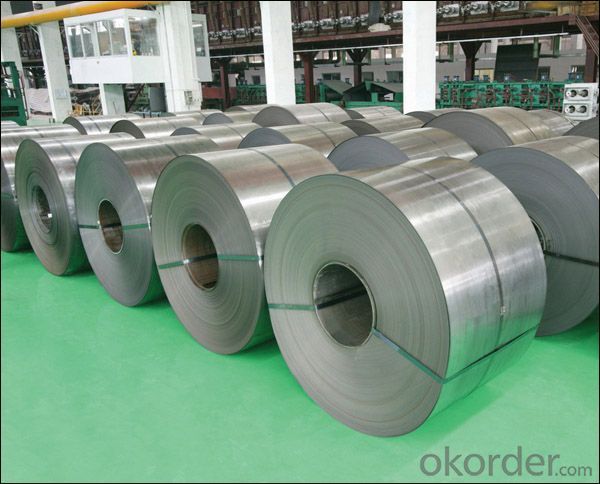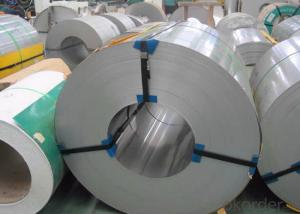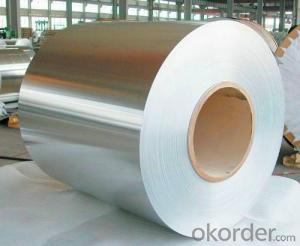Stainless Steel Coil Cold Rolled 304 With Good Quality
- Loading Port:
- Shanghai
- Payment Terms:
- TT OR LC
- Min Order Qty:
- 100 m.t.
- Supply Capability:
- 5000 m.t./month
OKorder Service Pledge
OKorder Financial Service
You Might Also Like
Item specifice
Stainless Steel Coil Cold Rolled 304 With Good Quality
1.Structure of Stainless Steel Coil Cold Rolled 304 With Good Quality
Cold Rolled stainless steel Coil with good quality is one of the raw material of the cold rolled stainless steel Coil, which can be used directly in many places. Stainless Steel (Stainless Steel) is short for acid-proof Stainless Steel, resistant to weak corrosive medium such as air, steam, water, or with a Stainless Steel grade.
2.Main Features of Prefabricated Steel Structure High Building Project
1) Weldability: The purpose of the different requirement for welding performance are different.1 Kind of tableware generally do not require the performance of welding, even including some pot class enterprise. But the vast majority of products all need raw materials welding performance is good, like the 2 kinds of tableware, thermos flask, steel pipes, water heaters, water dispensers, etc.
2) Corrosion resistance The vast majority of stainless steel products for corrosion resistant performance is good, like a, 2 kinds of tableware, kitchen utensils and appliances, water heaters, water dispensers, etc., some foreign businessmen on corrosion resistance of products also do experiment: in NACL aqueous solution heated to boiling, after a period of time the best solution, wash and drying, weight loss, to determine the degree of corrosion (note: the product polishing, because of the sand cloth or sandpaper containing Fe, will cause the test surface rust spots)
3. Stainless Steel Coil Cold Rolled 304 With Good Quality Images


4. Stainless Steel Coil Cold Rolled 304 With Good Quality Specification
The word "stainless steel" is not merely refers to a pure stainless steel, but said more than one hundred kinds of stainless steel industry, the development of each stainless steel has good performance in their specific applications. The key to the success of the first is to make clear purpose, and then determine the correct material. Related to architectural construction applications usually only six types of steel. They contain 17 ~ 22% chromium, good steel contains nickel. Add molybdenum can further improve the atmospheric corrosion resistance, especially containing chloride atmospheric corrosion resistance. Stainless steel often according to the state of organization can be divided into: martensite steel, ferritic steel, austenitic steel, austenitic (two-phase) - ferrite stainless steel and precipitation hardening stainless steel, etc. In addition, according to ingredients can be divided into: chromium stainless steel, chromium nickel stainless steel and chromium manganese nitrogen stainless steel, etc.
5. Applications of Stainless Steel Coil 304 With Good Quality
1. Kitchenware: tableware, cookware, Stoves…
2. Food packing: storage cans, food containers…
3. Construction: bridge, roofing, wall, decoration, bathroom accessories…
4. Precision instruments: electrical products, aerospace…
5. Others: automotive parts, machine building, chemical processing, farming…
6.FAQ of Stainless Steel Coil 304 With Good Quality
We have organized several common questions for our clients,may help you sincerely:
①How about your company?
A world class manufacturer & supplier of castings forging in carbon steel and alloy steel,is one of the large-scale professional investment casting production bases in China,consisting of both casting foundry forging and machining factory. Annually more than 8000 tons Precision casting and forging parts are exported to markets in Europe,America and Japan. OEM casting and forging service available according to customer’s requirements.
②How to guarantee the quality of the products?
We have established the international advanced quality management system,every link from raw material to final product we have strict quality test;We resolutely put an end to unqualified products flowing into the market. At the same time, we will provide necessary follow-up service assurance.
③How is the packaging and delivery?
Standard export packing (Coil: waterproof paper + protective steel ring; Circle: wooden box), or as your requirement and the delivery term is based on the project.
④How long can we receive the product after purchase?
In the purchase of product within 20 working days, We will arrange the factory delivery as soon as possible. The specific time of receiving is related to the state and position of customers. Commonly 20 to 40 working days can be served.
③How is the packaging and delivery?
Standard export packing (Coil: waterproof paper + protective steel ring; Circle: wooden box), or as your requirement and the delivery term is based on the project.
④How long can we receive the product after purchase?
In the purchase of product within 20 working days, We will arrange the factory delivery as soon as possible. The specific time of receiving is related to the state and position of customers. Commonly 20 to 40 working days can be served.
- Q:Can stainless steel strips be used in architectural roofing systems?
- Yes, stainless steel strips can be used in architectural roofing systems. Stainless steel is a durable and corrosion-resistant material, making it suitable for use in exterior applications such as roofing. It offers strength, longevity, and a modern aesthetic, making it a popular choice in architectural designs.
- Q:Can stainless steel strips be used in automotive exhaust systems?
- Yes, stainless steel strips can be used in automotive exhaust systems. Stainless steel is a popular material choice for exhaust systems due to its high corrosion resistance and durability. It can withstand extreme temperatures and harsh conditions, making it suitable for the exhaust system's demanding environment. Stainless steel strips are often used for the construction of exhaust pipes, mufflers, and other components due to their strength and ability to resist rust and corrosion. Additionally, stainless steel strips can be easily formed, welded, and shaped to meet the specific requirements of an exhaust system, making them an ideal choice for automotive applications.
- Q:How do you prevent microbiologically influenced corrosion of stainless steel strips?
- Microbiologically influenced corrosion (MIC) is a common problem in various industries, including the corrosion of stainless steel strips. To prevent MIC and maintain the integrity of stainless steel strips, several preventive measures can be implemented: 1. Material Selection: Choose stainless steel grades that are resistant to MIC, such as 316L or higher-grade alloys. These alloys contain higher levels of molybdenum, which enhances their resistance to microbiological corrosion. 2. Proper Surface Finish: Ensure that the stainless steel strips have a smooth and polished surface finish. Rough surfaces provide crevices and pits where microorganisms can thrive and initiate corrosion. Regular cleaning and polishing can help maintain the smoothness of the surface. 3. Regular Cleaning and Maintenance: Regularly clean and sanitize the stainless steel strips to remove any biofilms or organic matter that can harbor microorganisms. Use industry-approved cleaning agents and techniques to eliminate potential sources of microbial growth. 4. Biocide Treatments: Apply appropriate biocides or antimicrobial coatings to the stainless steel strips. These treatments can inhibit the growth of microorganisms and prevent the initiation of corrosion. However, it is essential to select biocides that are compatible with stainless steel to avoid any adverse reactions. 5. Environmental Control: Maintain proper environmental conditions by controlling temperature, humidity, and the presence of corrosive chemicals. Microorganisms thrive in certain conditions, and by controlling these factors, the growth of microbes can be minimized. 6. Cathodic Protection: Implement cathodic protection techniques, such as impressed current or sacrificial anode systems, to provide an additional layer of protection against corrosion. These techniques can help mitigate the effects of MIC on stainless steel strips. 7. Regular Inspection and Monitoring: Conduct regular inspections to identify any signs of corrosion or microbial growth on stainless steel strips. Implement a monitoring program that includes visual inspections, microbiological testing, and corrosion rate measurements to detect any early signs of MIC and take appropriate actions. By implementing these preventive measures, the risk of microbiologically influenced corrosion on stainless steel strips can be significantly reduced, ensuring their longevity and performance.
- Q:Can 111 stainless steel strips be used in the construction industry?
- Yes, 111 stainless steel strips can be used in the construction industry. Stainless steel strips are widely used in various construction applications such as roofing, cladding, structural supports, and decorative elements. The specific grade 111 may have certain properties that make it suitable for specific construction purposes, such as enhanced corrosion resistance or high strength. However, it is important to consult with an engineer or construction professional to ensure that the grade and specifications of the stainless steel strips meet the project requirements.
- Q:Can 111 stainless steel strips be used in geothermal power plants?
- Yes, 111 stainless steel strips can be used in geothermal power plants. Stainless steel is often used in such plants due to its high corrosion resistance and ability to withstand high temperatures and pressure, making it suitable for various components and equipment within the geothermal power generation process.
- Q:How do you prevent discoloration of stainless steel strips?
- One way to prevent discoloration of stainless steel strips is to regularly clean them with a mild detergent and water, followed by thorough drying. Additionally, avoiding exposure to harsh chemicals, such as bleach or ammonia, and abrasive materials can help maintain the integrity and appearance of the stainless steel.
- Q:Can stainless steel strips be used for structural applications?
- Stainless steel strips possess the ability to fulfill structural needs. This is due to stainless steel's exceptional resistance to corrosion, remarkable strength, and enduring nature, which render it suitable for a wide range of structural purposes. In the construction realm, stainless steel strips can be employed in the creation of buildings, bridges, and other infrastructure ventures. Moreover, they find utility in the production of machinery, automotive components, and household appliances. The adaptability of stainless steel strips allows for their manipulation into various shapes and sizes through forming, welding, and other techniques, thus making them an ideal choice for structural uses. Furthermore, the aesthetic appeal and minimal maintenance requirements of stainless steel contribute to its popularity in architectural contexts. In conclusion, stainless steel strips emerge as a trustworthy and efficient material for structural applications.
- Q:What are the different types of stainless steel strips?
- There are several different types of stainless steel strips, each with unique properties and applications. Some commonly used types include: 1. Austenitic Stainless Steel: This type is the most commonly used and has excellent corrosion resistance. It is non-magnetic, easily formable, and ideal for applications where high strength and good weldability are required. 2. Ferritic Stainless Steel: Ferritic strips are magnetic and have good corrosion resistance. They are less formable than austenitic stainless steel but have higher strength and are commonly used in automotive exhaust systems, decorative applications, and appliances. 3. Martensitic Stainless Steel: Martensitic strips are known for their high strength and hardness. They have moderate corrosion resistance and are often used in applications that require wear resistance, such as knives, blades, and turbine parts. 4. Duplex Stainless Steel: Duplex stainless steel strips combine the properties of both austenitic and ferritic stainless steels. They have excellent corrosion resistance, high strength, and good weldability. They are commonly used in industries such as oil and gas, chemical processing, and marine applications. 5. Precipitation Hardening Stainless Steel: Precipitation hardening strips have a unique combination of high strength and corrosion resistance. They can be heat treated to achieve even higher strength levels, making them suitable for aerospace and high-performance applications. It is essential to choose the right type of stainless steel strip based on the specific requirements of the application, such as corrosion resistance, strength, formability, and magnetic properties.
- Q:Can stainless steel strips be used in household appliances?
- Yes, stainless steel strips can be used in household appliances. Stainless steel is a common material choice for appliances due to its durability, resistance to corrosion, and easy maintenance. It is often used for refrigerator doors, stove tops, dishwashers, and other household appliances.
- Q:Can stainless steel strips be used for medical instruments?
- Yes, stainless steel strips can be used for medical instruments. Stainless steel is a popular choice for medical instruments due to its many advantageous properties. It is highly resistant to corrosion, which is crucial for maintaining cleanliness and preventing the spread of infections. Stainless steel is also durable and can withstand high temperatures and harsh sterilization processes, making it ideal for medical applications. Additionally, stainless steel is non-magnetic, which is important for certain medical imaging procedures. Overall, stainless steel strips are a reliable and commonly used material in the manufacturing of various medical instruments.
1. Manufacturer Overview |
|
|---|---|
| Location | |
| Year Established | |
| Annual Output Value | |
| Main Markets | |
| Company Certifications | |
2. Manufacturer Certificates |
|
|---|---|
| a) Certification Name | |
| Range | |
| Reference | |
| Validity Period | |
3. Manufacturer Capability |
|
|---|---|
| a)Trade Capacity | |
| Nearest Port | |
| Export Percentage | |
| No.of Employees in Trade Department | |
| Language Spoken: | |
| b)Factory Information | |
| Factory Size: | |
| No. of Production Lines | |
| Contract Manufacturing | |
| Product Price Range | |
Send your message to us
Stainless Steel Coil Cold Rolled 304 With Good Quality
- Loading Port:
- Shanghai
- Payment Terms:
- TT OR LC
- Min Order Qty:
- 100 m.t.
- Supply Capability:
- 5000 m.t./month
OKorder Service Pledge
OKorder Financial Service
Similar products
New products
Hot products
Related keywords





























